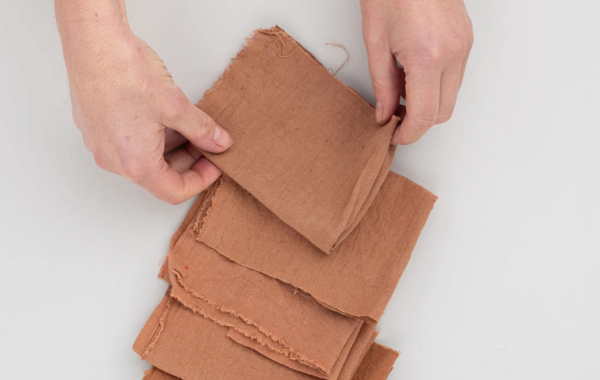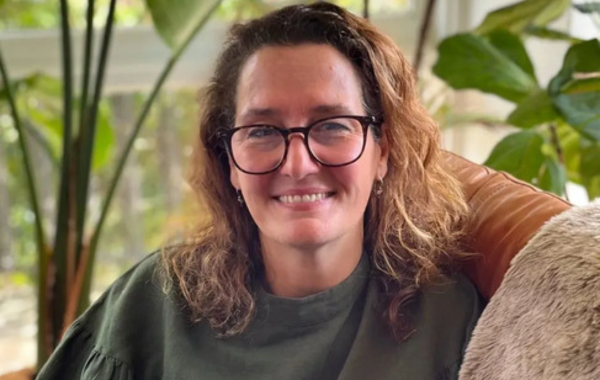Do natural fibers matter?

Natural dyes used on natural fabric. INSET: Owner of Fabric of Humanity, Kristen Morrison is passionate about helping people live a toxin-free lifestyle. Photos: FABRIC OF HUMANITY.
Behind every piece of clothing is a story of fabric, dyes, and used throughout the textile manufacturing cycle – and wearing these chemicals on our skin could be affecting our health.
Does our clothing contain chemical cocktails that we absorb through our skin? According to functional Nutritionist Claire Holmes, it does.
Holmes said nowadays, many dyes and fabrics contained a myriad of chemicals and heavy metals that we are absorbing through our skin.
“Our fabrics that we just get from, for example Target, contain flame retardants, bleaches, plastics, volatile organic compounds like phthalates and synthetics substances.
“The list can just go on and on. A big one in clothing is flame retardants.
“The chemicals in these clothing, they contain a lots of heavy metals, such as lead, antimony and aluminium.
“There’s a lot in those fabrics and they’re on our skin. And our skin just absorbs. If it goes into our skin, it goes into our bloodstream.”

Holmes said putting these things on our skin has a similar affect to eating the substances.
“At the Department of Health and Human Services’ Agency for Toxic Substances and Disease Registry, they rank arsenic as number one and lead as number two as the most toxic substances, and those two heavy metals are found in our dyes and our fabrics.”
Holmes said because there were so many toxic materials in the fabrics they could cause a build up in the body, known as toxic accumulation.
“Really small amounts can have a harmful effect.
“We’ve got a lot of research around the effects of these heavy metals individually on the body, but it’s the toxic cocktail of all of these chemicals and heavy metals on the body that has the real detrimental effects on someone’s health.
“If we have these toxic metals in these environments and we’re deficient in other minerals that are really helpful in detoxifying it can cause us really big impairments.
“These impairments can be from cognition, to behaviour – which we are seeing with ADHD and learning difficulties, intellect – it can really lower IQ, cardiovascular function, reproductive health – fertility and our hormones, skin – eczema and skin issues, genetic expression, immune function, liver and kidney function. The list goes on, it’s really quite scary.”
Holmes said at her work, she helped identity toxicity from heavy metals and chemicals, first using tissue analysis to determine what has accumulated in the body.
“Then I work to help detoxify the body using different minerals that have an antagonistic relationship with these chemicals. It really helps the body gently detox a lot of these heavy metals out of the body.”

She said using natural fibres was one simple way to start reducing exposure to chemicals and heavy metals.
“You just want as natural fibres as you can go, the less it’s been tampered with the better. We do have some great companies around Torquay as well, we’re really lucky. One of these companies is textile company Fabric of Humanity, which initially launched on the Bellarine, selling organics ethical and sustainable fabrics and dyes.
Fabric of Humanity owner Kristen Morrison was a Melbourne fashion designer for more than two decades and also ran organic cafes in Melbourne, with a focus on special diets and toxin-free living for families.
“The push for the use of more natural fibres in the textiles industry is as much about trying to reduce pollutants in the environment as it is about the health benefits of choosing natural fibres,” she said.
“Sleeping in bedding made from cotton, linen or bamboo for example is so much better for us because it allows our skin to breathe and helps us to better regulate temperature compared with sleeping in synthetic fibres.
“And the processing of synthetic fibres produces so much more toxic waste such as the release of micro plastics into our air & water, as well as the fumes produced by their manufacturing process.”
Morrison said natural dyes also only worked on natural fibres.
“So there’s a massive win-win when we choose naturally dyed products made from natural fibres. These pieces and literally every component of their manufacture is compostable and hypoallergenic, making it the logical choice for those of us who value our health as well as the environmental impact of our consumerism.”

















